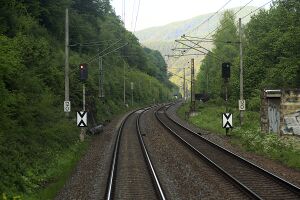Dev:Border between infrastructure managers and countries: Difference between revisions
| [checked revision] | [checked revision] |
m (moved photo) |
m (typo) |
||
| Line 28: | Line 28: | ||
This example can be used to represent handover point as it is defined in <ref>{{external|http://taf-jsg.info/wp-content/uploads/2023/07/20230426-JGS-Handbook-3.3-with-XSD-3.3.0.0.pdf|TAP TSI and TAF TSI Sector Handbook for the Communication between Railway Undertakings and Infrastructure Managers (RU/IM Telematics Sector Handbook) Submitted on 20th October 2022}}</ref>: “Point where legal responsibility changes between the infrastructure mangers. This can be but does not have to be in conjunction with a state border”. | This example can be used to represent handover point as it is defined in <ref>{{external|http://taf-jsg.info/wp-content/uploads/2023/07/20230426-JGS-Handbook-3.3-with-XSD-3.3.0.0.pdf|TAP TSI and TAF TSI Sector Handbook for the Communication between Railway Undertakings and Infrastructure Managers (RU/IM Telematics Sector Handbook) Submitted on 20th October 2022}}</ref>: “Point where legal responsibility changes between the infrastructure mangers. This can be but does not have to be in conjunction with a state border”. | ||
== References == | == References == | ||
Revision as of 11:50, 29 November 2023
Having Directive 2012/34/EU opening of the market for domestic passenger transport services by rail and the governance of the railway infrastructure and single European railway area implies that every country in Europe has a set of interoperable infrastructure managers. Sometimes infrastructure of different managers borders each other and a train can pass them.
Excerpts of source code addressing above problem may look like follows. In code there are two tracks belonging to two infrastructure mangers. Ownership is represented by <ownerChange> elements. Further information is given in the <infrastructureManager> element and corresponding code list (link to the railML® website).
Please be aware of correct definition of the railway tracks. Every railway track should have an <ownerChange> at the beginning of the track positioned at zero coordinate. Also, the additional semantic constraints apply like for the <speedChange> [1].
<metadata>
<organizationalUnits>
<infrastructureManager id="ima01" code="DBN"/>
<infrastructureManager id="ima02" code="SZD"/>
</organizationalUnits>
</metadata>
..
<trackBegin id="tb01" pos="0" absPos="0">
<ownerChange id="och01" pos="0" absPos="0" infrastructureMamagerRef="ima01"/>
..
<trackEnd id="tb01" pos="500" absPos="500">
..
<trackBegin id="tb02" pos="0" absPos="500">
<ownerChange id="och02" pos="0" absPos="500" infrastructureMamagerRef="ima01" name="Bahnverw.grenze Bad Schandau Gr"/>
..
<trackEnd id="tb02" pos="500" absPos="1000">
Real-world example of this concept can be found in the OpenRailwayMap defined for the Děčín–Dresden-Neustadt railway 6240 line. This line is operated be two railway operation managers Správa železnic of Czech Republic and Deutsche Bahn Netz of Germany. Schöna is a German railway station and Dolní Žleb is a Czech one.
This example can be used to represent handover point as it is defined in [2]: “Point where legal responsibility changes between the infrastructure mangers. This can be but does not have to be in conjunction with a state border”.
